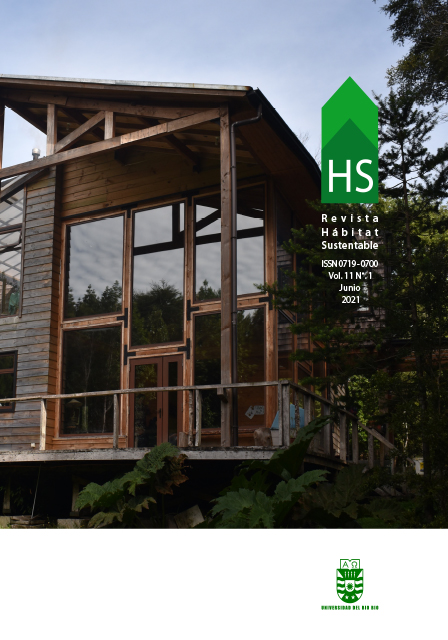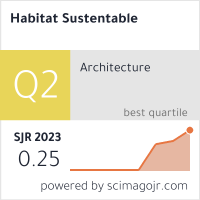Indicador de rendimiento laboral del usuario-trabajador de oficina en período de verano de clima templado cálido
DOI:
https://doi.org/10.22320/07190700.2021.11.01.04Palabras clave:
calidad ambiental, edificio de oficinas, tipologíaResumen
NOTIFICACIÓN DE RETRACTACIÓN
El Equipo Editorial de Hábitat Sustentable lamenta comunicar que retira el siguiente artículo publicado en el número V11N1 de junio de 2021 debido a un envío duplicado:
Alamino Naranjo Y., Alonzo Frank A. (2021) “Indicadores de rendimiento laboral del usuario-trabajador de oficina en período de verano de clima templado cálido”, Hábitat Sustentable Vol.11 N.01 (Junio de 2021), pp.: 44-57.
El manuscrito enviado a Hábitat Sustentable el 25 de febrero de 2021 coincide con el texto publicado en octubre-diciembre 2021.a la revista Informes de la Construcción, que lo publicó el segundo semestre del año 2021.
Alamino Naranjo Y., Kuchen E. (2021) “Indicadores para evaluar el rendimiento de usuarios de oficina en clima templado cálido”, Informes de la Construcción, Vol. 73, 564,e420, octubre-diciembre 2021. Disponible online: https://informesdelaconstruccion.revistas.csic.es/index.php/informesdelaconstruccion/article/view/6095.
Los autores al aceptar las normas editoriales de Hábitat Sustentable, indicando que el artículo no había sido enviado a otra revista, el Equipo Editorial comenzó un proceso de revisión editorial posterior al de Informes de la Construcción. Este proceso pasó por una triple ronda revisión de pares que contribuyó a la mejora sustancial del artículo. El resultado de este proceso fue la publicación de artículo en el número del primer semestre de 2021. En enero de 2022 el Equipo Editorial detectó que el artículo se encontraba publicado de forma duplicada y el caso fue enviado al Comité Ético de Publicaciones de la Facultad de Arquitectura, Construcción y Diseño. Este Comité, tras revisar las sugerencias en la página electrónica del Committee on Publication Ethics (COPE) y realizar diversas comprobaciones, ha aconsejado al equipo editorial retirar el artículo de la plataforma de la revista y visibilizar a través de esta nota las razones de la retractación.
Descargas
Citas
CANDANEDO, L. M. Y FELDHEIM, V. (2016). Accurate occupancy detection of an office room from light, temperature, humidity and CO2 measurements using statistical learning models. Energy and Buildings, 112, 28-39. DOI: https://doi.org/10.1016/j.enbuild.2015.11.071
DE DEAR, R. (2004). Thermal comfort in practice. Indoor air, 14(s 7), 32-39.
HAEGERSTRAND, A. Y KNUTSSON, E. (2019). The Attractive Workplace: ¿Are the Site Offices Meeting the Employees´ Needs? Recuperado de https://www.diva-portal.org/smash/record.jsf?pid=diva2%3A1335603&dswid=-2150
HUMPHREYS, M. A. Y NICOL, J. F. (2007). Self-assessed productivity and the office environment: monthly surveys in five European countries. ASHRAE transactions, 113, 606. Recuperado de https://www.proquest.com/openview/8cfc5a0731a88d2407b3521e54829ebe/1?pq-origsite=gscholar&cbl=34619
INSTITUTO NACIONAL DE ESTADÍSTICA Y CENSOS, ARGENTINA [INDEC]. (2010). Censo Nacional de Población, Hogares y Viviendas 2010. Recuperado de https://www. indec. gob. ar/indec/web/Nivel4-CensoNacional-999-999-Censo-2010.
IRAM (1996). 11603: Acondicionamiento térmico de edificios. Clasificación bioambiental de la República Argentina. Buenos Aires, Argentina.
KARI, T., MAKKONEN, M. Y FRANK, L. (2017). The Effect of Using Noise Cancellation Earplugs in Open-plan Offices of the Work Well-being and Work Performance of Software Professionals. En MCIS 2017: 11th Mediterranean Conference on Information Systems. MCIS. Recuperado de https://core.ac.uk/download/pdf/301373762.pdf
KUCHEN, E. Y FISCH, M. N. (2009). Spot monitoring: thermal comfort evaluation in 25 office buildings in winter. Building and Environment, 44(4), 839-847. DOI: https://doi.org/10.1016/j.buildenv.2008.06.023
LAMB, S. Y KWOK, K. C. (2016). A longitudinal investigation of work environment stressors on the performance and wellbeing of office workers. Applied Ergonomics, 52, 104-111. DOI: https://doi.org/10.1016/j.apergo.2015.07.010
LIEBL, A. Y JAHNCKE, H. (2017). Review of research on the effects of noise on cognitive performance 2014-2017. En 12th ICBEN conference on noise as a public health problem, 18-22 June 2017, Zurich, Switzerland. Recuperado de https://www.diva-portal.org/smash/record.jsf?pid=diva2%3A1119275&dswid=-4070
LIU, T., LIN, C. C., HUANG, K. C. Y CHEN, Y. C. (2017). Effects of noise type, noise intensity, and illumination intensity on reading performance. Applied Acoustics, 120, 70-74. DOI : https://doi.org/10.1016/j.apacoust.2017.01.019
LOU, H. Y OU, D. (2019). A comparative field study of indoor environmental quality in two types of open-plan offices: Open-plan administrative offices and open-plan research offices. Building and Environment, 148, 394-404. DOI: https://doi.org/10.1016/j.buildenv.2018.11.022
MARÍN GALEANO, A. F. (2013). La oficina administrativa como diseño espacial acorde a las necesidades del trabajador. Recuperado de https://repositorio.ucp.edu.co/handle/10785/1616
MAULA, H., HONGISTO, V., KOSKELA, H. Y HAAPAKANGAS, A. (2016). The effect of cooling jet on work performance and comfort in warm office environment. Building and Environment, 104, 13-20. DOI: https://doi.org/10.1016/j.buildenv.2016.04.018
MINETTI, J. L., CARLETTO, P. M., Y SIERRA, A. Y POBLETE. Y. E. (1986). El régimen de precipitaciones de San Juan y su entorno. Centro de Investigaciones Regionales de San Juan. Recuperado en: https://scholar.google.com/scholar_lookup?title=+El+r%C3%A9gimen+de+precipitaciones+de+San+Juan+y+su+entorno&author=Minetti+J.L.&publication_year=1986&pages=19-22
NAG, P. K. (2019). Spatial and Behavioural Attributes in Office Design. En Nag, P. K., Office Buildings (pp. 29-49). Singapur: Springer. Recuperado de https://link.springer.com/chapter/10.1007/978-981-13-2577-9_2
ORGANIZACIÓN INTERNACIONAL DEL TRABAJO [OIT]. Garantizar un tiempo de trabajo decente para el futuro. Recuperado de https://www.ilo.org/wcmsp5/groups/public/---ed_norm/---relconf/documents/meetingdocument/wcms_618490.pdf
PAN, S., XIONG, Y., HAN, Y., ZHANG, X., XIA, L., WEI, S., ... Y HAN, M. (2018). A study on influential factors of occupant window-opening behavior in an office building in China. Building and environment, 133, 41-50. DOI: https://doi.org/10.1016/j.buildenv.2018.02.008
PERUCCA, L. P. Y MARTOS, L. M. (2012). Geomorphology, tectonism and Quaternary landscape evolution of the Central Andes of San Juan (30 S–69 W), Argentina. Quaternary International, 253, 80-90. DOI: https://doi.org/10.1016/j.quaint.2011.08.009
PULIAFITO, S. E., ALLENDE, D. G., MULENA, C. G., CREMADES, P. Y LAKKIS, S. G. (2015). Evaluation of the WRF model configuration for Zonda wind events in a complex terrain. Atmospheric Research, 166, 24-32. DOI: https://doi.org/10.1016/j.atmosres.2015.06.011
SHIN, D. S., JEONG, B. Y. Y PARK, M. H. (2018). Structural equation modeling of office environment quality, sick building syndrome and musculoskeletal complaints on aggregate satisfaction of office workers. Human Factors and Ergonomics in Manufacturing & Service Industries, 28(3), 148-153. DOI: https://doi.org/10.1002/hfm.20730
SHRIRAM, S., RAMAMURTHY, K. Y RAMAKRISHNAN, S. (2019). Effect of occupant-induced indoor CO2 concentration and bioeffluents on human physiology using a spirometric test. Building and Environment, 149, 58-67. DOI: https://doi.org/10.1016/j.buildenv.2018.12.015
WARGOCKI, P. Y WYON, D. P. (2017). Ten questions concerning thermal and indoor air quality effects on the performance of office work and schoolwork. Building and Environment, 112, 359-366. DOI: https://doi.org/10.1016/j.buildenv.2016.11.020
WEATHER ATLAS Recuperado de: https://www.weather-atlas.com/ [Diciembre, 2020].
WEI, W., WARGOCKI, P., ZIRNGIBL, J., BENDŽALOVÁ, J. Y MANDIN, C. (2020). Review of parameters used to assess the quality of the indoor environment in Green Building certification schemes for offices and hotels. Energy and Buildings, 209. DOI: https://doi.org/10.1016/j.enbuild.2019.109683
WU, H., WU, Y., SUN, X. Y LIU, J. (2020). Combined effects of acoustic, thermal, and illumination on human perception and performance: A review. Building and Environment, 169, 106593. DOI: https://doi.org/10.1016/j.buildenv.2019.106593
YANG, W. Y MOON, H. J. (2019). Combined effects of acoustic, thermal and illumination conditions on the comfort of discrete senses and overall indoor environment. Building and Environment, 148, 623-633. DOI: https://doi.org/10.1016/j.buildenv.2018.11.040
Publicado
Cómo citar
Número
Sección
Licencia
Derechos de autor 2021 Yesica Alamino-Naranjo, Alcion Alonso-Frank

Esta obra está bajo una licencia internacional Creative Commons Atribución-CompartirIgual 4.0.
El contenido de los artículos que se publican en cada número de Hábitat Sustentable, es responsabilidad exclusiva de los autores y no representan necesariamente el pensamiento ni comprometen la opinión de la Universidad del Bío-Bío.
Los autores/as conservarán sus derechos de autor y garantizarán a la revista el derecho de primera publicación de su obra, el cuál estará simultáneamente sujeto a la Licencia de Reconocimiento de Creative Commons CC BY-SA que permite a otros compartir-copiar, transformar o crear nuevo material a partir de esta obra con fines no comerciales, siempre y cuando se reconozcan la autoría y la primera publicación en esta revista, y sus nuevas creaciones estén bajo una licencia con los mismos términos.











 Programa de Información Científica/Concurso Fondos de Publicación de Revistas Científicas 2018/ Proyecto Mejoramiento de Visibilidad de Revistas UBB (Código:FP180007)
Programa de Información Científica/Concurso Fondos de Publicación de Revistas Científicas 2018/ Proyecto Mejoramiento de Visibilidad de Revistas UBB (Código:FP180007) 





